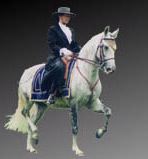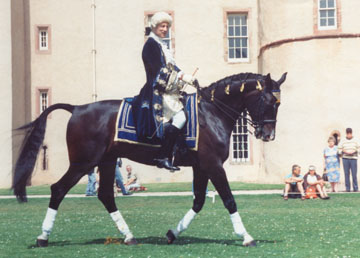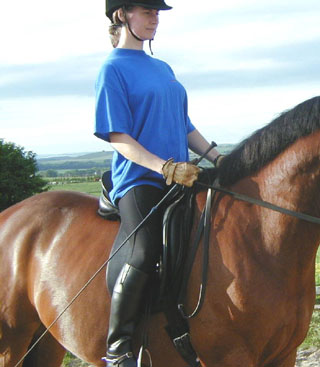 |
classicaldressagescotland.com |
| Lesson 3: The rider's position |
| New web address: www.classicaldressagescotland.com |  |
| About this site | About us | Personal Tuition | Video analysis | Lesson menu | Portugal and Lusitanos |
| Home Schooling Classical dressage Modern dressage Horse trials Show jumping Glossary Links |
There are many books, magazine articles, pamphlets,
cave wall paintings, videos and even tablets of stone about this
subject - yet it would seem to me that there should be only one
rule and that is: 'If your horse is comfortable and can move
with freedom and ease and you, the rider, is comfortable and
can move with freedom and ease, then you have cracked the problem.
You are in the correct position.'

Not so long ago I was invited to teach a clinic in a yard near Glasgow, Scotland. One of the clients was a young lady riding a lovely young thoroughbred horse. Although the young lady was ramrod straight in the saddle, she looked as though she really did not want to be in my class and the horse just wanted to be on another planet. This was not a happy pair and the horse and rider team spirit was truly down the pan. After talking to the young lady for a few minutes, it soon became clear that she was under the impression that dressage was some sort of torture and that this part of her riding was her punishment in exchange for enjoying her cross country riding. She had been taught that the only way she could sit correctly, train and ride her horse on the flat was to contort her body into such weird positions that it had become both painful and distressing. Her horse was so confused and uncomfortable in his back, compared to his lovely soft forward going gallop across country, that he was starting to shy and nap, hollow his back and carry his head up far too high. I just taught her to chill out a little and passed on to her a little of what I knew about the classical seat. Last I heard she was winning on the same horse at novice events and she had plans to bring on a youngster for dressage. Although what I said above may seem a little simplistic, I cannot stress enough that your position and seat are very important parts of your training for you and your horse. To put him on the bit, to improve his paces in the movements, in fact everything you do with your horse in the future. And remember, if you are not exactly the same shape as Reiner Klimke or Artur Kottas, or any of the great grand prix stars, you will have to make compromises and allowances and work with the body you have. Now let's try a little experiment. Take a two pound (1 kilo) bag of sugar out of the cupboard. Can you hold the sugar at arms length? Yes, of course you can. Now hold the sugar at arms length for thirty minutes. Difficult! Now you know what your horse will feel like after you have ridden him for thirty minutes in a bad position. Now put the sugar on top of your head. That's right, the sugar is over your centre of balance. Therefore you can stand or even move around the room like that for hours and maintain your balance. (By the way, I suggest you do this in private for obvious reasons.) It's the same with your horse. If you are supple and in balance with your horse, both you and he can work correctly and for a longer period of time without getting tired or sore. So, how do you get a good position? Relax your mind and your body. No tension. Sit on your horse in front of a mirror or ask a friend to check. You should sit with a vertical line straight down from your ear, shoulder, hip and heel. It will feel strange at first but practise. Forget the knee rollers on your saddle if it's not a dressage saddle. The position is more important at this stage. Try and reach back and down from the hip towards the horses back foot falls. Don't just bend the knee until the heels come up under your 'bottom' or your 'butt' (depending on nationality) to get the straight line from shoulder, hip and heel. Your back should be straight and relax your waist. Sit straight and relax your buttocks. (The cracking walnuts with the cheeks of your bum/butt syndrome). Check the mirror, or with your friend. Are you still sitting straight? Sit relaxed without any force in any part of your body. If you are tight or rigid, your horse will be tight and rigid.
I remember when I first started to ride and I wanted 'the perfect seat' I was always being criticised for a round back. I was working in a desk-bound job and I was bringing my poor posture back to my horse. Every time I tried to straighten my back, I would go stiff. As soon as I realised I was stiff, my back rounded. A vicious circle. The owner of the yard where I was riding at that time gave me a tip that has always worked for me. Perhaps it will for you. When I arrived home from work in those days, I would quickly jump into my boots and breeches and, to save time, did not change out of my shirt collar and tie. My friend told me to take an ordinary drawing pin (thumb tack) and push it through my collar and tie, so that the point of the pin would stick into my neck if I pressed the back of my neck into and against the back of my collar. All I felt was a slight jab on the back of my neck but, while I felt that point, that slight sharp sensation, I was sitting straight. Don't concentrate on the back, concentrate on feeling the back of the collar. Try it, it could solve your posture problem if you have one. All this will take practise and remember the seat and your balance will become easier as your horse improves, becomes more balanced himself and achieves self-carriage. It's easier to sit on a trained horse rather than a novice. The last thought I will leave you with this month bearing in mind rider's position and balance is: Lunging lessons are never a waste of time. It's the only time you can totally concentrate on yourself. Not many chances in your life for that! Hope you enjoyed this month's lesson. If you have any problems, please email me. If you have any comments, please email me. And don't forget, always reward your horse, it's the only way he will know he is correct.
|
 Take
your reins so there is a straight line from your elbow to the
bit. Elbows near your body. Your hands in-front of the saddle
and above the wither. It will depend on the size of horse and
the length of your arms for the length of the rein. Legs around
the horse, try and keep your legs soft, supple and against his
sides. This will depend on the barrel of the horse. Relax your
upper body and arms so that you can influence your horse with
your back (subject of a future monthly lesson - 'Back Aids').
Check the mirror or your friend and start to move the horse.
RELAX! It will take practice. Allow your back to move. Sit straight
and allow every part of the body to ripple downwards. Don't push
too hard with your seat; don't force, especially in canter. Don't
grind into your horses back. To ride school movements or change
direction, do not take the inside rein to turn your horse. Move
him around circles or corners using your legs. Move your shoulders
so that they are always parallel to the horse's shoulders. Keep
your back and waist relaxed to that they can move with the horse.
Keep your legs near your horse and let the weight of your leg
drop down into the stirrup. Don't grip up or hold with the knees.
What will keep you on the horse are poise, balance and a good
dose of gravity. Check the mirror. When you change pace or ride
a transition, do not lean forward or back. Stay in balance. Keep
you bottom (butt) soft and in contact. Try to feel and listen
with your seat. If your seat moves more than your horses back,
you will break the connection and communication.
Take
your reins so there is a straight line from your elbow to the
bit. Elbows near your body. Your hands in-front of the saddle
and above the wither. It will depend on the size of horse and
the length of your arms for the length of the rein. Legs around
the horse, try and keep your legs soft, supple and against his
sides. This will depend on the barrel of the horse. Relax your
upper body and arms so that you can influence your horse with
your back (subject of a future monthly lesson - 'Back Aids').
Check the mirror or your friend and start to move the horse.
RELAX! It will take practice. Allow your back to move. Sit straight
and allow every part of the body to ripple downwards. Don't push
too hard with your seat; don't force, especially in canter. Don't
grind into your horses back. To ride school movements or change
direction, do not take the inside rein to turn your horse. Move
him around circles or corners using your legs. Move your shoulders
so that they are always parallel to the horse's shoulders. Keep
your back and waist relaxed to that they can move with the horse.
Keep your legs near your horse and let the weight of your leg
drop down into the stirrup. Don't grip up or hold with the knees.
What will keep you on the horse are poise, balance and a good
dose of gravity. Check the mirror. When you change pace or ride
a transition, do not lean forward or back. Stay in balance. Keep
you bottom (butt) soft and in contact. Try to feel and listen
with your seat. If your seat moves more than your horses back,
you will break the connection and communication.